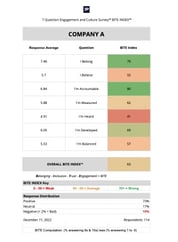Walt Brown joined host Ralph Brogden as a guest on the Rebelpreneur Radio interview segment titled How to Transform Organizational Culture With the 7 Question - 7 Promise Framework.
The show begins with Walt explaining how he started out as an accounting nerd, moved on to running his own companies, and sold them in August of 2006. He explains how he was encouraged to get into coaching and facilitation by several of his peers. By September of 2006 Walt had 33 clients and was invited by nine of them to assist with pivoting their organizations.
Walt talks about how entrepreneurs have a vision in their minds of the type of organization they want to have. When they get to the next steps, they need to be able to slow down and make sure they’re surrounding their vision and strategy with the right people who all buy into it. Walt says we need to be able to force ourselves to get out of the day-to-day affairs, and actually evaluate the system and identify ways to improve it.
Walt talks about the Entrepreneurial Operating System, and how it was designed based on a framework of six components that every championship team has. If you have ten companies competing, only two can be in the championship game, and everyone on a championship team has to be on the same page with what the vision is. You have to surround that vision with the right people in the right seats, you have to agree on what data should be used to measure success.
From there, Walt says everyone has to agree with what it means to be on the same page in terms of measuring success and what data is meaningful. Then, you have to create a transparent organization, which causes issues to be made visible. If you can’t make your issues go away, you’re going to trip over the same things over and over again. Also, you need to have individual accountability and discipline. Walt says this is where the 7Q7P Framework emerged from.
The conversation shifts to a discussion about how people must pay attention to issues while they’re small before they get bigger. Using a plate-spinning analogy, Walt says one of the biggest frustrations is to get all the plates in the air, only for several plates to fall once one gets moving, and the momentum needs to be rebuilt. The eventual goal is to build an organization where you can turn control over to the people within it and allow them to turn the crank and power it themselves.
Walt is asked why it is so difficult to get people in alignment, and he answers by saying it starts with the leaders, shifts to the leadership team, and then finds its way to the rest of the people in the organization. Walt categorizes leaders as “thinkers” and managers as “doers.” If a program fails, it always occurs because the CEO or owner has failed to buy-in. The owner has to be ready for the change, and it is helpful if the owner realizes it isn’t efficient for them to be doing everything. If they can surround themselves with complementary pieces, their lives will improve substantially.
Walt says it’s a fact that an organization is a fiction that is only given meaning and power by those that buy into it. If a fifty-person organization is split into two groups of 20-plus that follow two different visions, then it is divided and on its way to being conquered. No one dreams about starting a company in which the staff is divided.
Around client #85, Walt became fed up with hearing about the millennial stereotype. It didn’t jibe with his concept of what millennials believed in and stood for because those he knew seemed prepared to take over the world. Through the implementation of EOS, Walt’s clients were forced to describe what “yes” looked like to seven fundamental things. By executing the system, the business was able to maintain alignment with the seven questions.
Walt explains how the goal was to create one single organization where everyone could understand what it meant to belong. Everyone should be able to believe in the organization’s values and priorities. People should understand and embrace what they are accountable for, how they are measured, how the organization listens and how opinions are heard, how they’re developed, and what balance means to the organization. If everyone can say “yes” to those seven things, then you will be able to create a healthy culture that is unstoppable and has a ton of momentum.
Walt says the principles of 7Q7P apply to everyone, but there’s a lot of hard work involved at the beginning stages. Leadership has to get on the same page with the employees about what it means to be balanced, and they need to make expectations clear about the time requirements of the job. It also needs to be clear that if individuals realize they can’t continually align with the values and mission of the organization, then they should opt-out of the company because the company’s trajectory doesn’t align with that individual’s future goals.
Walt says he encourages potential clients and other interested parties to do surveys that allow people to see the areas they’re weak in. The problem is, if people see shortcomings, many don’t have EOS or another operating system as a ready-made tool to get things aligned. Walt says he doesn’t care which system an organization opts to use as long as it provides the results, and people think things are being done for them and not to them. Employees should be encouraged to question management’s decisions on the basis of the seven questions.
Walt closes the show by mentioning his book The Patient Organization, along with the 7Q7P workshops he runs in Chapel Hill, North Carolina, and encourages people to reach out to him at 7Q7P.com.





